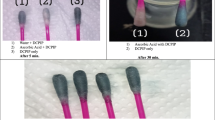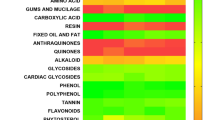Abstract
The aim of this study was to explore the effect of capsaicin and particular phenolic compounds profile from cellulase assisted extracts of Habanero (Capsicum chinense) chili pepper seeds (CPS) on the concentration of cytokines (IL-2, IL-6, TNF-α, IL-1β) in murine macrophages (RAW 264.7) stimulated with lipopolysaccharides (LPS). Capsaicin was quantified by HPLC–DAD, and the phenolic profile was determined by UPLC-MS-QqQ. Anti-inflammatory activity was evaluated by Mouse Cytokine/Chemokine Magnetic Bead Panel 96-well plate assay. Among the 15 different phenolics found in CPS extracts obtained at 120 or 150 min of maceration with 2,500 UI/L at 30 ºC or 45 ºC in a 1:15 (w:v) proportion, the most abundant was vanillic acid (7.97–12.66 µg/g). The extract obtained at 30 ºC and 120 min, showed similar effects than the observed for synthetic anti-inflammatory drugs indomethacin and dexamethasone, and capsaicin standard. Beyond capsaicin, salicylic, protocatechuic and trans-cinnamic acids as well as vanillin in CPS extracts were correlated with the anti-inflammatory effect. On the other hand, capsaicin and chlorogenic acid contents were potential immunostimulants whose concentration varied depending on the cellulase treatment time.



Similar content being viewed by others
Data Availability
The datasets generated during and/or analyzed during the current study are available from the corresponding author on reasonable request.
References
Panchal SK, Bliss E, Brown L (2018) Capsaicin in metabolic syndrome. Nutrients 10:14–18. https://doi.org/10.3390/nu10050630
Bassi MS, Gentile A, Iezzi E et al (2019) Transient receptor potential vanilloid 1 modulates central inflammation in multiple sclerosis. Front Neurol 10:1–8. https://doi.org/10.3389/fneur.2019.00030
Anaya-Esparza LM, de la Mora ZV, Vázquez-Paulino O et al (2021) Bell peppers (Capsicum annum L.) losses and wastes: source for food and pharmaceutical applications. Molecules 26:1–23. https://doi.org/10.3390/molecules26175341
Rodrigues CA, Zomer APL, Rotta EM et al (2022) A μ-QuEChERS method combined with UHPLC-MS/MS for the analysis of phenolic compounds in red pepper varieties. J Food Compos Anal 104647. https://doi.org/10.1016/J.JFCA.2022.104647
Cho SY, Kim HW, Lee MK et al (2020) Antioxidant and anti-inflammatory activities in relation to the flavonoids composition of pepper (Capsicum annuum L.). Antioxidants 9:1–11. https://doi.org/10.3390/antiox9100986
Acquavia MA, Pascale R, Pappalardo I et al (2021) Characterization of quercetin derivatives in crossing combination of habanero white and Capsicum annuum peppers and of anti-inflammatory and cytotoxic activity. Separations 8. https://doi.org/10.3390/separations8070090
Pappalardo I, Santarsiero A, De Luca M et al (2021) Exploiting the anti-inflammatory potential of white capsicum extract by the nanoformulation in phospholipid vesicles. Antioxidants 10:1–15. https://doi.org/10.3390/antiox10111683
Cione E, Plastina P, Pingitore A et al (2019) Capsaicin analogues derived from n-3 polyunsaturated fatty acids (PUFAs) reduce inflammatory activity of macrophages and stimulate insulin secretion by β-cells in vitro. Nutrients 11. https://doi.org/10.3390/nu11040915
Bessler H, Djaldetti M (2017) Capsaicin modulates the immune cross talk between human mononuclears and cells from two colon carcinoma lines. Nutr Cancer 69:14–20. https://doi.org/10.1080/01635581.2017.1247893
Cortes-Ferre HE, Antunes-Ricardo M, Gutiérrez-Uribe JA (2022) Enzyme-assisted extraction of anti-inflammatory compounds from habanero chili pepper (Capsicum chinense) seeds. Front Nutr 9:942805. https://doi.org/10.3389/fnut.2022.942805
Juárez-Trujillo N, Monribot-Villanueva JL, Jiménez-Fernández VM et al (2018) Phytochemical characterization of Izote (Yucca elephantipes) flowers. J Appl Bot Food Qual 91:202–210. https://doi.org/10.5073/JABFQ.2018.091.027
Othman ZAA, Ahmed YBH, Habila MA, Ghafar AA (2011) Determination of capsaicin and dihydrocapsaicin in Capsicum fruit samples using high performance liquid chromatography. Molecules 16:8919–8929. https://doi.org/10.3390/molecules16108919
Kim E-H, Min Lee K, Lee S-Y et al (2021) Influence of genetic and environmental factors on the contents of carotenoids and phenolic acids in red pepper fruits (Capsicum annuum L.). Appl Biol Chem 64:85. https://doi.org/10.1186/s13765-021-00657-8
dos Anjos GL, Moreira GC, Carneiro CN, de Dias F, S, (2022) Effect of phytoregulators on the composition of phenolic compounds in chili peppers (Capsicum frutescens) and exploratory analysis. Sci Hortic 292:110660. https://doi.org/10.1016/J.SCIENTA.2021.110660
Surendran A, Siddiqui Y, Ali NS, Manickam S (2018) Inhibition and kinetic studies of cellulose- and hemicellulose-degrading enzymes of Ganoderma boninense by naturally occurring phenolic compounds. J Appl Microbiol 124:1544–1555. https://doi.org/10.1111/JAM.13717
Pettinato M, Casazza AA, Perego P (2019) The role of heating step in microwave-assisted extraction of polyphenols from spent coffee grounds. Food Bioprod Process 114:227–234. https://doi.org/10.1016/J.FBP.2019.01.006
Pyrillou K, Burzynski LC, Clarke MCH (2020) Alternative pathways of IL-1 activation, and its role in health and disease. Front Immunol 11:3288. https://doi.org/10.3389/FIMMU.2020.613170/BIBTEX
Chen C-W, Lee ST, Wu WT et al (2003) Signal transduction for inhibition of inducible nitric oxide synthase and cyclooxygenase-2 induction by capsaicin and related analogs in macrophages. Br J Pharmacol 140:1077–1087. https://doi.org/10.1038/sj.bjp.0705533
Chandradevan M, Simoh S, Mediani A et al (2020) 1H NMR-Based metabolomics approach in investigating the chemical profile, antioxidant and anti-inflammatory activities of Gynura procumbens and Cleome gynandra. Plant Foods Hum Nutr 75:243–251. https://doi.org/10.1007/s11130-020-00805-3
Xie B, Li XY (2019) Inflammatory mediators causing cutaneous chronic itch in some diseases via transient receptor potential channel subfamily V member 1 and subfamily A member 1. J Dermatol 46:177–185. https://doi.org/10.1111/1346-8138.14749
Vasanthkumar T, Hanumanthappa M, Lakshminarayana R (2019) Curcumin and capsaicin modulates LPS induced expression of COX-2, IL-6 and TGF-β in human peripheral blood mononuclear cells. Cytotechnology 71:963. https://doi.org/10.1007/S10616-019-00338-X
Allemand A, Leonardi BF, Zimmer AR et al (2016) Red Pepper (Capsicum baccatum) extracts present anti-inflammatory effects in vivo and inhibit the production of TNF-α and NO in vitro. J Med Food 19:759–767. https://doi.org/10.1089/jmf.2015.0101
Hudita A, Galateanu B, Costache M et al (2021) In vitro cytotoxic protective effect of alginate-encapsulated capsaicin might improve skin side effects associated with the topical application of capsaicin. Molecules 26. https://doi.org/10.3390/molecules26051455
Bok E, Chung YC, Kim KS et al (2018) Modulation of M1/M2 polarization by capsaicin contributes to the survival of dopaminergic neurons in the lipopolysaccharide-lesioned substantia nigra in vivo. Exp Mol Med 50. https://doi.org/10.1038/s12276-018-0111-4
Malagarie-Cazenave S, Olea-Herrero N, Vara D et al (2011) The vanilloid capsaicin induces IL-6 secretion in prostate PC-3 cancer cells. Cytokine 54:330–337. https://doi.org/10.1016/J.CYTO.2011.03.010
Viveros-Paredes JM, Puebla-Pérez AM, Gutiérrez-Coronado O et al (2021) Capsaicin attenuates immunosuppression induced by chronic stress in BALB/C mice. Int Immunopharmacol 93:107341. https://doi.org/10.1016/J.INTIMP.2020.107341
Mudgal J, Basu Mallik S, Nampoothiri M et al (2020) Effect of coffee constituents, caffeine and caffeic acid on anxiety and lipopolysaccharide-induced sickness behavior in mice. J Funct Foods 64:103638. https://doi.org/10.1016/J.JFF.2019.103638
Ye J, Gao Y, Ji M et al (2021) Oral SMEDDS promotes lymphatic transport and mesenteric lymph nodes target of chlorogenic acid for effective T-cell antitumor immunity. J Immunother Cancer 9:2753. https://doi.org/10.1136/jitc-2021-002753
Acknowledgements
The authors acknowledge to Italmesa Company to provide the Habanero chili pepper seeds and to ENMEX S.A. de C.V. to contribute with Celluzyme used in this research.
Funding
This work was financially supported by the “Consejo Nacional de Ciencia y Tecnologia (CONACyT)” for the scholarship 2018–000068-02NACF-07952 and by the “Instituto Tecnológico de Estudios Superiores de Monterrey”. J.A.G.A. and J.L.M.V. acknowledge funding from CONACyT (grant number 316998) for the annual maintenance of the UPLC-MS platform used in this work for phenolics profiling.
Author information
Authors and Affiliations
Contributions
H.E.C.F. prepared the first version of the manuscript and performed most of the experimental work. M.M.A. and M.A.R. performed an initial analysis of phenolic compounds, cytokines quantification and reviewed the manuscript last version. J.A.G.A and J.L.M.V. identified and quantified the phenolic compounds and reviewed the last version of the manuscript. J.A.G.U. designed and supervised the experiment and generated the last version of the manuscript.
Corresponding author
Ethics declarations
Ethics Approval and Consent to Participate
Not applicable.
Consent for Publication
All the material is owned by the authors and/or no permissions are required.
Competing Interest
The authors confirm that they have no conflict of interest with respect to the work described in this manuscript.
Additional information
Publisher's Note
Springer Nature remains neutral with regard to jurisdictional claims in published maps and institutional affiliations.
Supplementary Information
Below is the link to the electronic supplementary material.
Rights and permissions
Springer Nature or its licensor (e.g. a society or other partner) holds exclusive rights to this article under a publishing agreement with the author(s) or other rightsholder(s); author self-archiving of the accepted manuscript version of this article is solely governed by the terms of such publishing agreement and applicable law.
About this article
Cite this article
Cortés-Ferré, H.E., Martínez-Avila, M., Antunes-Ricardo, M. et al. In vitro Evaluation of Anti-Inflammatory Activity of “Habanero” Chili Pepper (Capsicum chinense) Seeds Extracts Pretreated with Cellulase. Plant Foods Hum Nutr 78, 109–116 (2023). https://doi.org/10.1007/s11130-022-01026-6
Accepted:
Published:
Issue Date:
DOI: https://doi.org/10.1007/s11130-022-01026-6




